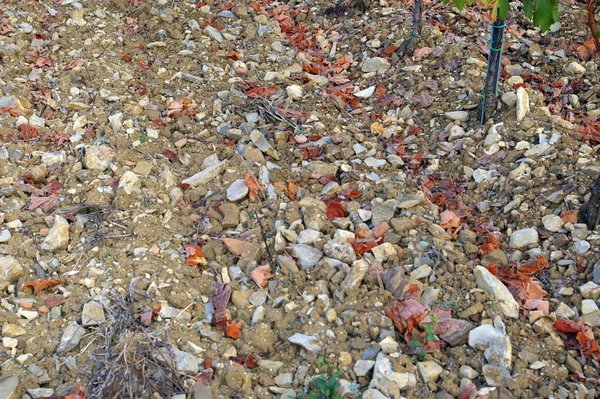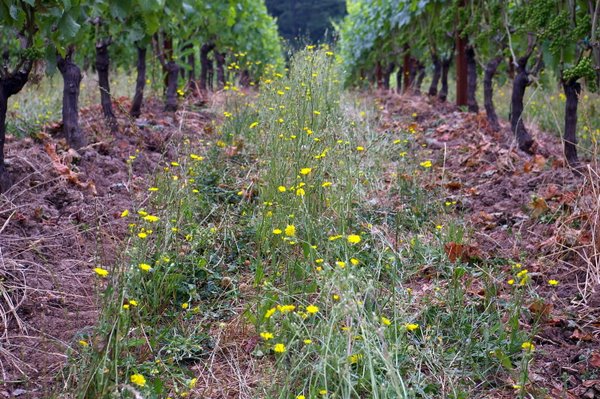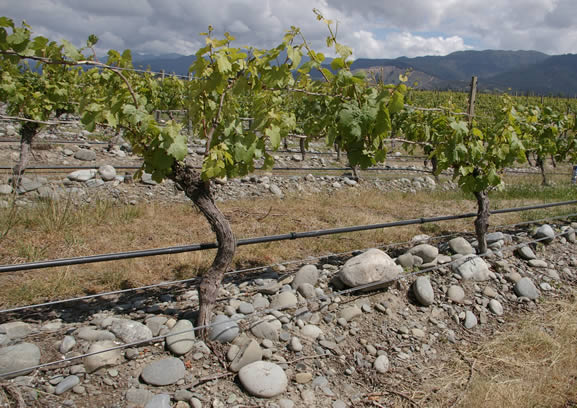|
Terroir
Baggage

One
of the most interesting concepts in wine is that of terroir – the
notion that a wine can possess a sense of place. This local flavour
derives from the way that grapevines are sensitive to the physical
properties of the vineyard environment, including both the local
microclimate and the characteristics of the soil. It's a very
important concept because it underpins the wide diversity of wine
styles: not only do the different grape varieties produce wines that
taste different, but also the same variety will make different wines
depending on where it is grown.
The
problem with terroir is that it is both blindingly obvious and hotly
controversial at the same time. There is no doubt that small
differences between sites, in terms of their soil properties and
microclimates, result in grapes with different properties which then
carry through into wines.
It's
easy to illustrate this by comparing wines made identically in the
same winery, with the same grape variety, but from different
vineyards. They taste different- sometimes subtly; sometimes markedly.
There you are: terroir’s existence is proved.
But
then comes the controversy. The term 'terroir' is badly defined and
means different things to different people. And because terroir is
'proved', and we know it exists, we're also expected to accept all the
widely held supplementary notions about terroir – terroir baggage,
in effect.

One
of these pieces of baggage is the idea that terroir is the most
important factor in determining the taste of a wine. I've heard it
stated that terroir is more important than cépage
(grape variety) in determining the taste of a wine. Well, I don't
think it is. It's actually a rather fragile influence, easily lost by
bad viticulture or heavy handed winemaking. The difference between
vineyards, as expressed in wine, is often a subtle one. But this
doesn't mean that it isn't important.
Another
piece of baggage is that the new world doesn't have terroir in the
same way the old world does. This is clearly nonsense, from first
principles. Vineyard sites differ in the new world just as they do in
the old, and so there's the potential for 'terroir' there just as much
in the old world. But it's probably true that new world wines in
general are less marked by their terroir differences, and that because
winegrowers tend to buy into the terroir concept less, this is not
such an important emphasis in their work.
I'd
add to this that many new world wines are made from warm sites where
the fruit attains greater ripeness. Very sweet fruit obscures the
subtle terroir influence, as does the use of new oak. Ripe, sweet
wines with plenty of oak influence don't tend to show the effects of
terroir very plainly. Also, new world winemaking tends to be cleaner,
with fewer non-fruit flavours in the wine. Often, non-fruit flavours
of spice, meat, earth and minerality – which can come from the
sometimes wine faults brettanomyces and reduction – are often
confused with terroir in the old world. You get more of these flavours
in old world wines.
Here
we encounter another piece of baggage. It's often said that young
vines don't express terroir, and that proper terroir expression only
comes from deep rooted vines that sink their feet deep into the soil
to extract all sorts of goodness, minerality and flavour from deep
under the surface. This runs into the idea that we get a 'taste of the
soil' in our wine. The link between soil/earth/rocks and wine is a
powerfully seductive notion. We're getting all this complex flavour in
a wine from a great vineyard – it must come from somewhere. So does
it come from the soil?
The
answer from science seems to be 'not really'. Soils are important in
determining the flavour of wine, but only indirectly. It is thought
that the most significant property of vineyard soil is its water
holding capacity. Soils which allow the vine as much water as it wants
aren't good: these encourage big, vigorous vines with an emphasis on
growing lots of shoots and leaves rather than fruit. The best
vineyards allow the vines a slow, steady supply of water which then
tails off towards the end of the growing season, at the time the fruit
is maturing. Good drainage is a helpful feature.

The
second important property of soil is its fertility. Big deep, fertile
loamy soils may be great for growing nice vegetables, but rich soils
that are great for other crops are usually bad for wine. This is
because fertile soils encourage the grapevine to grow vegetatively.
That is, the vine grows big leafy canopies and isn't all that bothered
about growing good fruit. Less fertile soils reduce vine vigour, which
is usually a good thing for fruit quality.
The
soil's chemical make-up can be significant, but not all that much is
known about the precise details here. Soil chemistry is likely to have
an indirect on grape properties by altering gene expression in the
grapevine, but not through direct translocation of flavour compounds
from the soil to the developing berries.
The
microbial communities in the soil may be significant. Healthy soils
are teeming with fungi and bacteria that could in some way influence
vine growth, either through helping with complex nutrient availability
or through signalling in some way to the vine through its roots.
One
further thought: terroir can influence quality without necessary
stamping geographic identity of the wine. A vineyard may be designated
as a special place for growing grapes because it produces wines that
don't necessarily taste of a particular place strongly, but which are
consistently better than those of another vineyard in the same locale.
After
all, what is this 'somewhereness' that good vineyards possess? We talk
about sense of place, but how exactly is it that a place shows itself
in a wine other than the self-referential association of wine flavours
with localities through repeated experience of those wines. Drinking a
great Chambertin might take an experienced taster in their mind to
Burgundy, but isn't that just an association they have made? Sometimes
the wine flavour seems to fit with the locality; other times there are
sites that make wines that are distinctive and typical, but where it's
hard to see a link between the typical wine flavour of the area and
the physical characteristics of that area. Besides, who gets to decide
what the authentic expression of a particular terroir is? Often,
different producers will make rather different yet equally compelling
interpretations of the same vineyard site.
These
are all interesting questions, and the lack of clear-cut answers is
what keeps the subject of terroir such a fertile ground for robust
discussions.
Back to top
|

